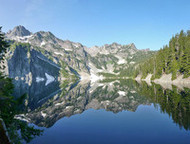Alpine Lake Fly Fishing
It’s the dog days of summer, and it is hot. Many trout waters are on hoot owl restrictions and many others are getting close to that 70 degree mark. It’s time to lay off the typical fly fishing streams and go on an adventure.
Alpine lake fly fishing can be an adventure in and of itself. I live in the Northwest, so the options are abundant. We’ve got the Cascades to the west, the Panhandle to the East, and a whole bounty of options in Oregon, Colorado and Utah. The west is not unique for Alpine lakes though. There are a multitude on the east coast as well.
Finding the Right Lake
Finding them is not that difficult these days. You can find just about anything you need to on line. Look up a prospective state Department of Wildlife and Fish and Game.
It you think you’ve picked out a certain spot, I do recommend a phone call. This can save you a lot of trouble and get you where you need to be. They can let you know if it’s an easy drive to the lake, off road, a hike or horseback. I’ve had two major knee reconstructions, this bit of information is pretty darn important to me. I strongly recommend for anyone though, bad knees aside. It’s good to know what you’re getting into. You can also get camping info, predator info, and of course wildfire info as well.
Packing Gear
On to the fishing. Generally speaking, you want lighter gear. I pack my 3wt and my 4wt. Due to colder climate, less prolific forage, and a short growing period, the fish tend to be smaller. Not always, there are exceptions. There are areas in central Idaho where a 20” cutty is not uncommon.
Get to Know Your Lake
Get to know your lakes, the fish, and the hatch. Some lakes are all native, some are stocked every year, or two, or three etc. Your native lakes will hold cutthroat, tiger, and bull trout most likely while stocked lakes tend to be stocked with rainbows and occasionally browns.
Lakes in the 3,000 ft. to 5,000 ft. level tend to have some prolific hatches, damsels amongst them. They really don’t lack for food or growing season. Studies on Davis Lake in Oregon have indicated that the trout can grow up to 5 inches in a year! Most folks refer to these lakes as mid-level lakes and not necessarily alpine lakes.
The further up you go in elevation, the more sparse the food source for the trout. The bad news, it can be challenging getting there. The good news, the trout are hungry and will hit just about anything!
As you head upwards of the 5,000 mark to the 6, 7 and 8,000 elevations the water gets colder, the forage is far less, and the fish are voracious. They tend to be on the smaller side. A two pound trout at 8,000 foot would be consider a monster sized trout.
Once you experience the pure joy of surrounding yourself in some of the most beautiful areas in the world, the quiet and solitude, and catching 50 fish in a day…..I guarantee you you’ll be hooked for like.
So get away from the norm, head to the mountains and give it a try!
Fish Hard, Fish Often and Fish On!







